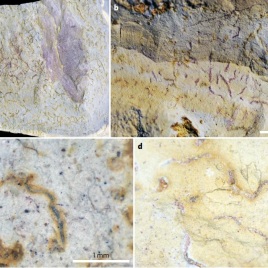According to the fossil records, nearly all animal phyla appeared within a relatively short timespan, dubbed the Cambrian Explosion due to its brevity and significance. But a recent study is contributing to another narrative, one that suggests the “explosion” wasn’t as sudden as scientists first thought, and that favourable circumstances had been lining up since the preceding […]
Tag: fossil
New toothed fossil the missing link between ancient and modern baleen whales
Scientists finally found the missing evolutionary link between the modern whales’ toothed ancestors, the basilosaurids, and the filter-feeding mysticetes, which include the blue whale, the humpback whale, and the right whale. A recent paper describes a 36.4-million-year-old whale fossil with teeth and small vestigial hind limbs, which also help connect it to the whales’ ancient land-dwelling […]
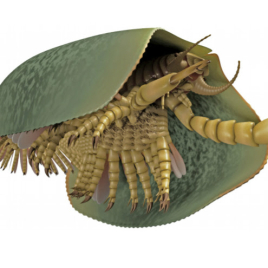
Burgess Shale fossil helps trace the evolution of the mandible 
The mandibulates, who get their name from their distinctive jaws, make up the largest group of arthropods. But the evolutionary origin of their unique bodies has remained murky until a recent discovery at the Burgess Shale Formation in British Columbia. A Tokummia katalepsis fossil found in the 508-million-year-old Marble Canyon deposit possesses physical traits typical […]
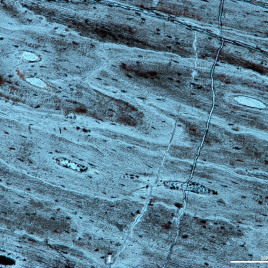
Oldest protein found in a 195-million-year-old dinosaur bone 
A new discovery beat the record for the oldest preserved protein by over 100 million years. Researchers used a new technique to examine a 195 million-year-old bone of a Lufengosaurus dinosaur without risking contamination. Their analysis showed traces of preserved collagen in parts of the bone where blood would pass through. Typically, soft tissue in […]
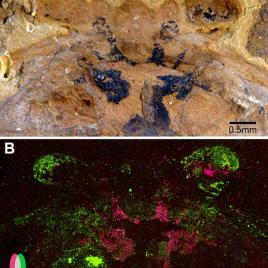
Proving paleontology wrong
Researchers have found what they believe is definitive evidence that brains do fossilize. In 2012 Nicholas Strausfeld co-authored the first ever report of a fossilized brain in an edition of Nature, however the findings were widely doubted as only one sample was found. Strausfeld and his team have now found seven fossil of the same […]
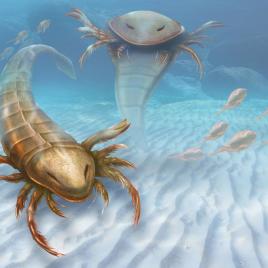
New species of giant sea scorpion
An ancient species of giant sea scorpion, Pentecopterus, which could grow up to six feet in length, has been identified after examining more than 150 fossil specimens of both adult and juvenile specimens. The fossils were uncovered in Iowa and lived approximately 460 million years ago. The species likely lived in a shallow mix of […]
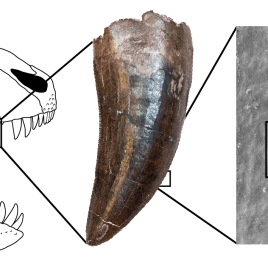
T. Rex’s secret weapon: Revealing a unique tooth structure
The unique tooth structure of carnivorous theropods such as Tyrannosaurus rex allowed them to tear through the flesh and bones of other dinosaurs with ease, and likely led to their success according to new research. The research team found that the deeply serrated structure, and the special arrangement of tissue inside, strengthened the teeth and […]
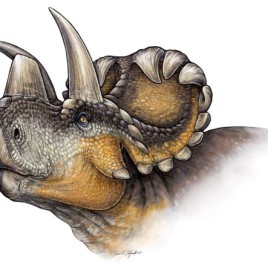
New species of horned dinosaur provides insight into Triceratops family evolution
A new species of horned dinosaur discovered in southern Alberta provides new information about the evolution of the Triceratops family of dinosaurs, the Ceratopsidae. The new species, Wendiceratops pinhornensis, is identified by 184 bones from at least four individuals. The Wendiceratop is an early species of horned dinosaur, living alongside the Albertaceratops, approximately 79 million […]
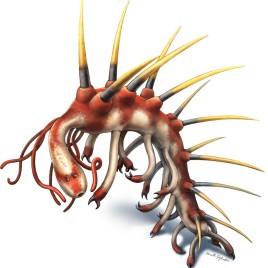
Completing the puzzle of arthropod evolution
Newly discovered fossils from the Burgess Shale region are providing scientists with evidence of the evolutionary history of arthropods, a group including insects, spiders and crustaceans. The fossils have also allowed scientists to gather a complete picture of what Hallucigenia, an arthropod existing 508 millions years ago, looked like. The new fossils show that Hallucigenia had […]
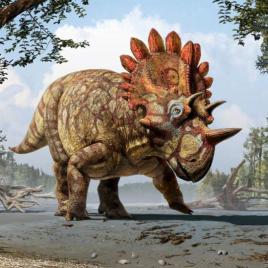
New species of horned dinosaur found in Alberta
Bones found 10 years ago along the Oldman River in Alberta belonged to a new species of horned dinosaur. This is the first time an horned dinosaurs species has been discovered in Alberta. According to a new study, this dinosaur is similar in many respects to Triceratops, except that its nose horn is taller and the […]
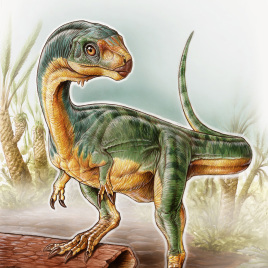
“Platypus” dinosaur discovered by seven-year-old boy
A new species of dinosaur seemingly made up of parts from other dinosaurs, similar to the modern day platypus, has been found by seven-year-old Diego Suárez in Chile. The species was named after Suárez, Chilesaurus diegosuarezi, and belongs to the theropod group of dinosaurs and is closely related to the Tyrannosaurus rex. However the Chilesaurus […]
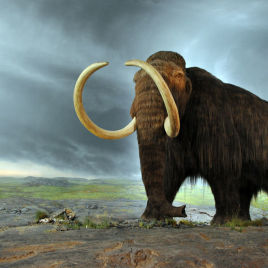
Discovering the hidden secrets of the woolly mammoth genome
Complete genome sequencing of two woolly mammoth (Mammuthus primigenius) specimens that lived approximately 4,300 and 44,800 years ago has been completed by researchers. The younger specimen was a member of one of last surviving mammoth populations. The researchers concluded that the woolly mammoth experienced a temporary population decline before recovering. This resulted in a reduction […]
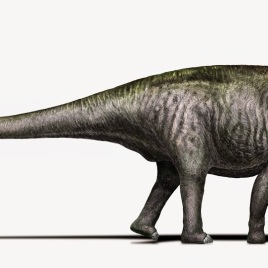
Brontosaurus did exist
While previously studies had suggested that Brontosaurus were the same species as Apatosaurus, a recent analysis has raised doubts about this. Paleontologists applied new statistical approaches to fossils to calculate the differences between species and genera of similar dinosaurs such as the Diplodocus, the Apatosaurus and the Brontosaurus. The differences were large enough reinstate Brontosaurus […]
Earliest known giant filter-feeding sea creature
New fossils from Morocco represent the earliest known giant filter-feeding sea creature, Aegirocassis benmoulae. These creatures could exceed two meters in length and fed on plankton much the same way modern whales do. Scientists think the animals went extinct because there was not enough plankton at the time (around 450 million years ago) to allow […]
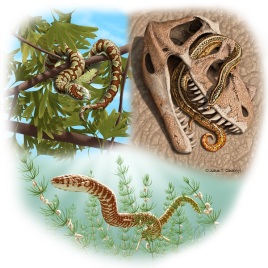
Oldest fossilized snakes ever found
Researchers have found the oldest known snake fossils ever discovered, pushing back the first record of snakes by 70 million years. The authors suggest that the fossils hint that the classic snake head evolved first and was then followed by the evolution of the elongated, limbless body. Studying fossilized skull bones found in England, Portugal […]
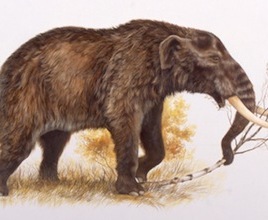
Resolving a mastodon mystery in the Yukon
A re-examination of mastodon fossils from Alaska and the Yukon indicates that they are much older than previously thought. Previous studies dated the fossils to the last ice age, about 18,000 years ago. However, at that time the area was largely grassland, and mastodons were forest-dwelling animals. The new study used modern radiocarbon dating methods […]
